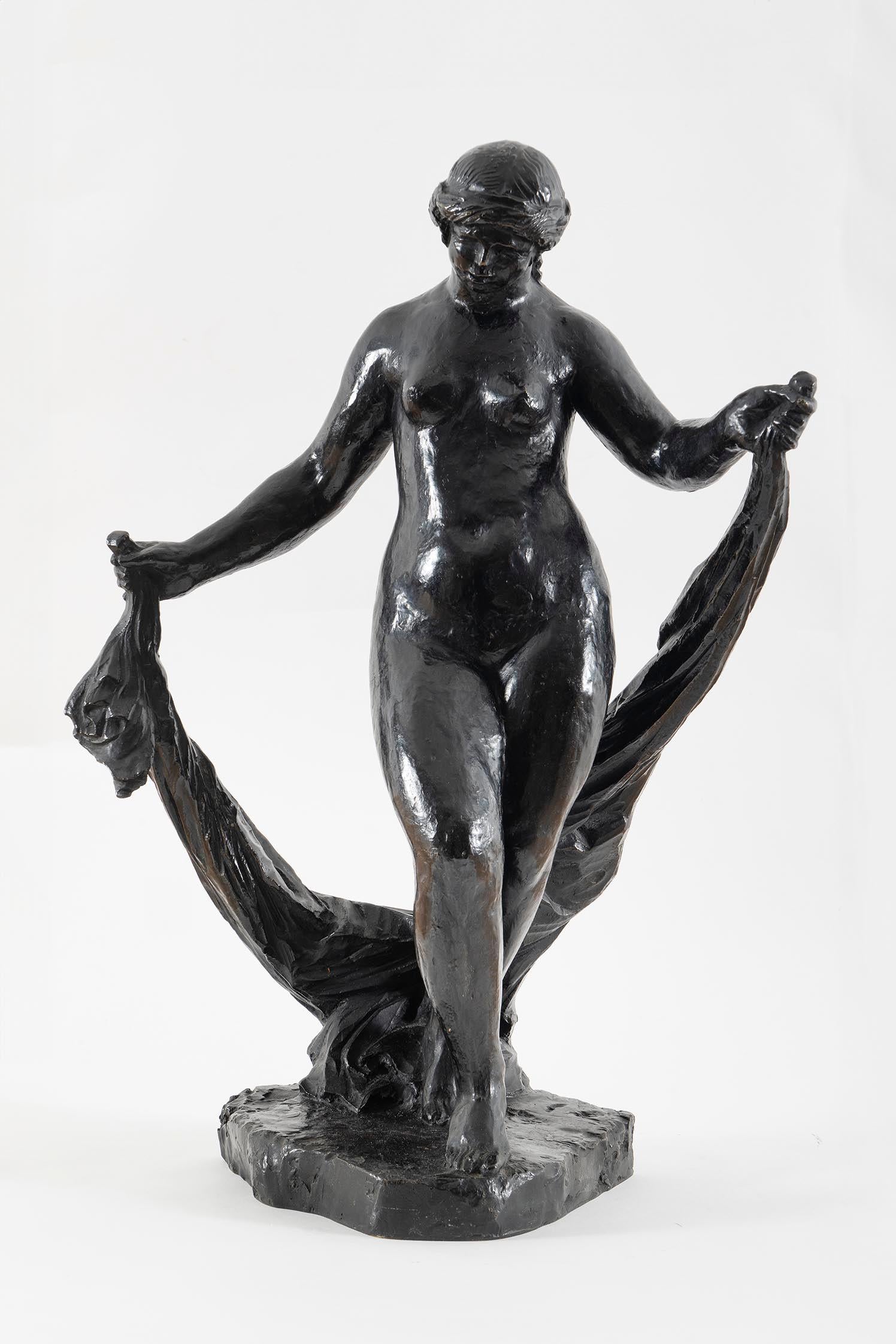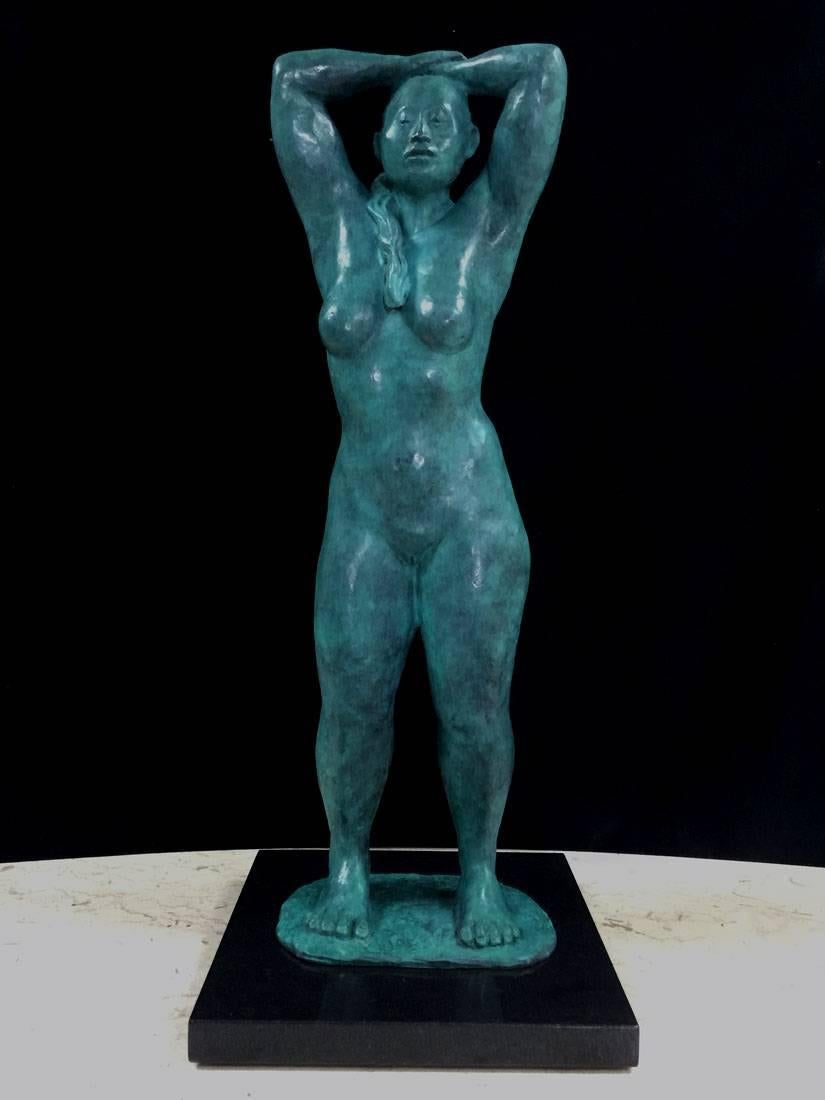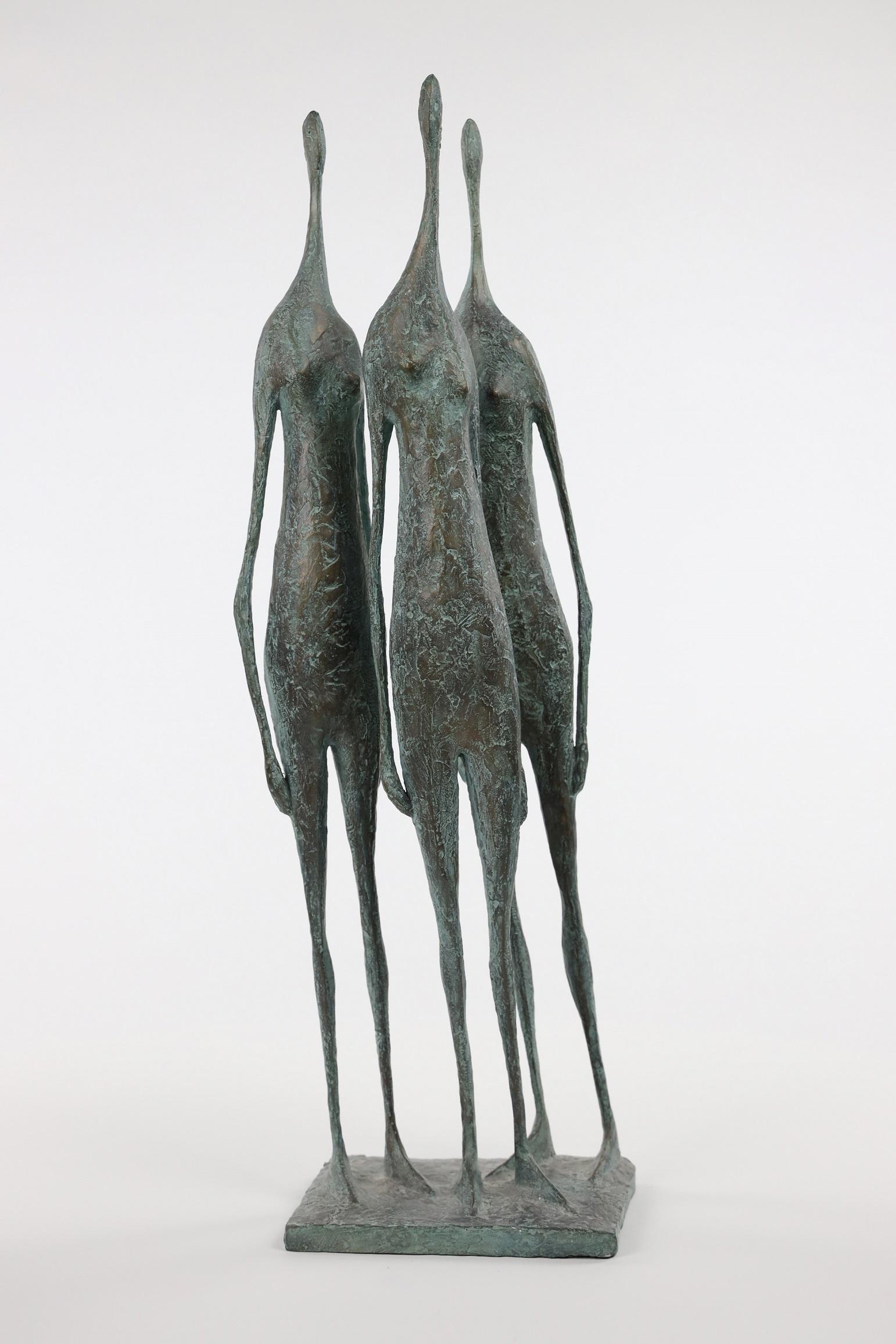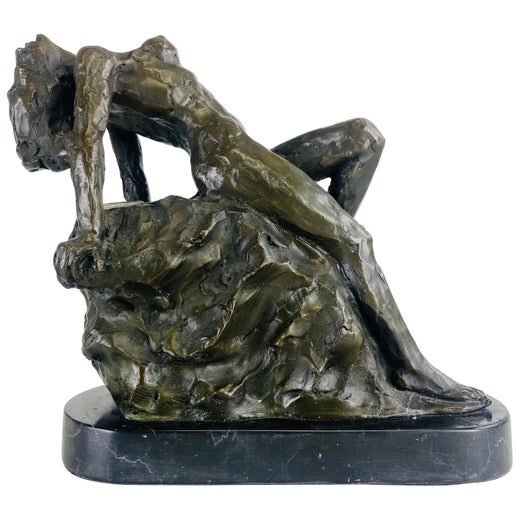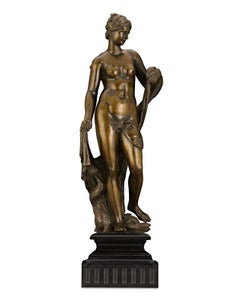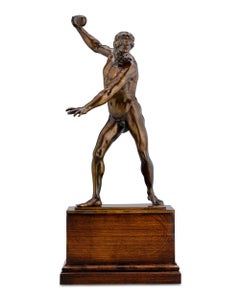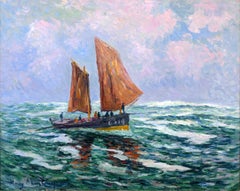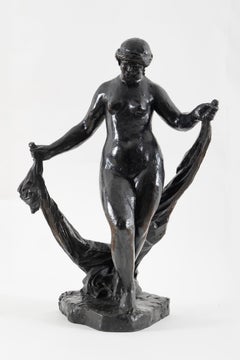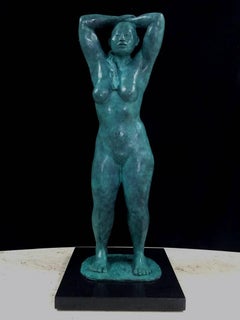Items Similar to L'Éternel Printemps by Auguste Rodin
Want more images or videos?
Request additional images or videos from the seller
1 of 9
Auguste RodinL'Éternel Printemps by Auguste RodinCirca 1905-10
Circa 1905-10
$1,285,000
£981,062.88
€1,123,660.49
CA$1,800,279.22
A$2,012,932.43
CHF 1,055,867.15
MX$24,381,444.80
NOK 13,328,246.16
SEK 12,591,972.23
DKK 8,387,012.02
About the Item
Auguste Rodin
1840-1917 French
L'Éternel Printemps
(The Eternal Spring)
Bronze with brown patina
Signed "Rodin" (on base), with Barbedienne foundry mark
Perhaps one of the most well-known and celebrated sculptures of his oeuvre, Auguste Rodin's passionate bronze L'Éternel Printemps is the embodiment of this artist's rare genius. Conceived in 1884, the bronze is regarded as one of the masterpieces of his mature output, conveying a sensuality and aura of passionate love from every angle.
This work was conceived at the height of Rodin's career in 1884, during an intense period of work on his pivotal Gates of Hell commission. It tells the age-old narrative of forbidden love, depicting the affair of Francesca da Rimini and Paolo Malatesta, who famously appear in Dante's Inferno for their transgression. Highlighting the lovers' bliss rather than their ultimate punishment, Rodin felt the bronze was too joyful and removed it from his Gates of Hell. Instead, he executed it as a stand-alone sculpture that would become one of his most acclaimed and beloved works. The Kiss, another masterpiece by the sculptor, shares a similar origin and subject, though L'Éternel Printemps is more dynamic in its pose.
Rodin's technical mastery was unmatched in his day, and by the turn of the century, he was regarded as the best sculptor since Michelangelo. His composition is dynamic from every angle, utilizing negative space in the arch of the woman's back and her lover's outstretched arm to create movement and feeling. Like many of his major works, Rodin looked back to one of his previous models in order to develop his amorous lovers. The female figure is based on his sensuous Torso of Adèle (Musée Rodin, Paris), which appears in the upper left-hand corner of the tympanum of his Gates of Hell. L'Éternel Printemps is also believed to resemble Camille Claudel, a sculptor with whom Rodin began a passionate affair after she joined his studio in 1882. The autobiographical element of Rodin's own forbidden love perhaps accounts for the work's intimacy and intensity.
After its successful showing at the Salon of 1897, Rodin awarded the casting of this bronze to the Barbedienne foundry in 1898. This sculpture is from the founder's second reduction, meaning it is the second largest of four versions they produced. It was also importantly cast during Rodin's lifetime and thus under his supervision, between 1905-1910. Other versions of this bronze can be found in museums worldwide, including the Musée Rodin (Paris), the Metropolitan Museum of Art (New York), the Museum of Fine Arts (Boston) and others.
Auguste Rodin is counted among the greatest artists of the late 19th and early 20th centuries, along with names such as van Gogh, Monet and Renoir. In the history of sculpture, he occupies a place even more important than his painterly contemporaries, for he alone revived the art of sculpture, returning it to prominence among mainstream art. During the mid-1870s, after two decades of struggling as an artist, Rodin visited Italy and studied the works of Michelangelo, who inspired his first major work, The Bronze Age. Exhibited in Brussels in 1877, it was so well received that the State purchased the work in 1880, which led to the commission of Rodin's The Gates of Hell. His works, so naturalistic and expressive in detail, were far removed from conventional, decorative sculpture and ultimately transformed the history of art. Today, he is widely regarded as the father of modern sculpture.
This important work is accompanied by a letter from the Comité Auguste Rodin confirming it will be included in the forthcoming Catalogue Critique de l’Oeuvre Sculpté d’Auguste Rodin by Jérôme Le Blay.
Conceived in 1884; cast between 1905-1910
20 1/4" high x 26" wide x 13" deep
Provenance:
Private Collection, Argentina, acquired in the 1910s
Private Collection, France
M.S. Rau, New Orleans
Private Collection, Texas
M.S. Rau, New Orleans
- Creator:Auguste Rodin (1840 - 1917, French)
- Creation Year:Circa 1905-10
- Dimensions:Height: 20.25 in (51.44 cm)Width: 26 in (66.04 cm)Depth: 13 in (33.02 cm)
- Medium:
- Movement & Style:
- Period:
- Condition:
- Gallery Location:New Orleans, LA
- Reference Number:Seller: 32-14281stDibs: LU18616751272
Auguste Rodin
Auguste Rodin was a French sculptor widely regarded as the father of modern sculpture. Breaking away from the idealized forms of classical sculpture, Rodin introduced a more naturalistic, emotionally charged style that emphasized texture, movement, and human emotion. His work often explored themes of love, struggle, and the human condition. Rodin's most iconic works include The Thinker, The Kiss, and The Gates of Hell, many of which began as smaller studies and evolved into monumental masterpieces. His innovative approach to form, fragmentation, and surface detail challenged traditional academic norms and set a new direction for modern sculpture. Despite initial criticism and controversy, Rodin’s work was eventually celebrated as groundbreaking, and he achieved widespread recognition during his lifetime. Today, his sculptures are displayed in major museums and public spaces worldwide, symbolizing the transition from classical to modern art.
About the Seller
5.0
Vetted Professional Seller
Every seller passes strict standards for authenticity and reliability
Established in 1912
1stDibs seller since 2013
17 sales on 1stDibs
Typical response time: 10 hours
- ShippingRetrieving quote...Shipping from: New Orleans, LA
- Return Policy
Authenticity Guarantee
In the unlikely event there’s an issue with an item’s authenticity, contact us within 1 year for a full refund. DetailsMoney-Back Guarantee
If your item is not as described, is damaged in transit, or does not arrive, contact us within 7 days for a full refund. Details24-Hour Cancellation
You have a 24-hour grace period in which to reconsider your purchase, with no questions asked.Vetted Professional Sellers
Our world-class sellers must adhere to strict standards for service and quality, maintaining the integrity of our listings.Price-Match Guarantee
If you find that a seller listed the same item for a lower price elsewhere, we’ll match it.Trusted Global Delivery
Our best-in-class carrier network provides specialized shipping options worldwide, including custom delivery.More From This Seller
View AllBronze of Amphitrite after Michel Anguier
Located in New Orleans, LA
After Michel Anguier
French 1612-1686
Amphitrite
Bronze
This remarkable bronze masterpiece was cast after a High Baroque masterwork by French sculptor Michel Anguier. After traini...
Category
17th Century Baroque Nude Sculptures
Materials
Bronze
Labors of Hercules Bronze Sculpture, 17th Century
Located in New Orleans, LA
A rare example of late Renaissance sculpture, this impressive Italian bronze captures one of the greatest divine heroes of myth and legend: Hercules. The figure is rendered with stun...
Category
17th Century Baroque Nude Sculptures
Materials
Bronze
Barque De Peche En Mer By Henry Moret
By Henry Moret
Located in New Orleans, LA
Henry Moret
1856-1913 French
Barque de Peche en Mer
Fishing Boat at Sea
Signed and dated “Henry Moret 1912” (lower left)
Oil on canvas
A beautiful gestural composition imbued with the sublime beauty of the open sea, this oil on canvas by Impressionist Henry Moret showcases the artist's deft use of color and texture. One of the most celebrated painters of the Pont-Aven School, Moret’s lasting reputation is tied to his talent for capturing the bright skies, lively waterways and the diverse coastline of northern France. With a mastery of plein air composition and a deep appreciation for the natural world, Moret's Barque de Peche en Mer renders a fishing boat navigating through the ocean. Moret creates a visceral sense of the vitality of the water and the enormity of the open skies. The artist captures the vigorous energy of the sea with a profusion of green and blue hues applied with a thick impasto. Small yet mighty against the infinite backdrop, Moret's fishing boat forges ahead.
Henry Moret was born in Cherbourg in 1856, though little else is known about his early life. He entered military service as a young man in 1875, and it was during that period when Moret discovered the beauty of France’s northern coasts, particularly those of Normandy and Brittany. After his tour ended, he embarked on his artistic career, completing his formal education at the École Nationale des Beaux-Arts under Jean-Leon Gérôme, and later, from about 1880, under Jean-Paul Laurens at the Académie Julian.
He exhibited for the first time at the Paris Salon in 1880, submitting a landscape of the coast of Brittany. During his time in Paris, he frequently traveled to Brittany to paint the region he so loved. In 1888, he more firmly established himself in Pont-Aven, a town whose center had become an artistic refuge for artists such as the great Paul Gauguin, Ernest Ponthier de Chamaillard, Emile Jourdan and others. Under Gauguin's influence, he briefly explored the concept of Symbolism in his works, but after Gauguin left Pont-Aven in 1891, Moret returned to his Impressionist roots. He formed a relationship with the famed dealer Durand-Ruel in 1895, and his career was officially launched. Today, his works can be found in important museums including the Manchester Art Gallery, the State Hermitage Museum (St. Petersburg), the National Gallery of Art (Washington DC) and others.
Dated 1912
Canvas: 28 3/4” high x 36 3/4” wide
Frame: 36 5/8" high x 44 1/8" wide
Exhibited:Henry Moret, Galerie Durand-Ruel, April 5-January 29, 1966, n° 47
Provenance:
Sale Marcel Bernheim...
Category
20th Century Impressionist Landscape Paintings
Materials
Canvas, Oil
Après le bain (After the bath)
By Pierre Auguste Renoir
Located in New Orleans, LA
For Pierre-Auguste Renoir, Impressionism's pre-eminent figure painter, depicting the nude was an exercise in bringing the canvas to life. He once said, “I look at a nude, I see myriads of minuscule shades. I have to find those which will make the flesh on my canvas come to life and resonate.” This compelling portrait by Renoir entitled Après le bain presents the nude figure of a woman in a serene, private moment, absorbed in the task of drying herself after a bath. The artist’s mastery of light and shading is incredible, achieving a sense of vitality in this otherwise ordinary scene.
Renoir is celebrated for his figural work, especially his Rubenesque female nudes, however, it was not until the artist was in his forties that he depicted the nude with any frequency. In 1881, Renoir traveled to Italy, where he studied the works of the Renaissance masters and the ancient art of Pompeii and Rome. Upon his return to France, the nude became his favored subject, and he used the motif to combine the spontaneity of Impressionism with the solid modeling of classical painting. Renoir’s medium here, sanguine, a reddish-brown chalk, was used extensively in the Renaissance by Leonardo (who employed it in his sketches for the Last Supper), Michelangelo and Raphael. Its warm hue lends itself well to depicting flesh, and the chalk drawing allows for a greater focus on line, form and texture in a departure from the aspects of color and light that so often preoccupied the Impressionists. Après le bain conveys the impression of arrested motion with perfect naturalness, deftly capturing the moment before the elegant lines of the sitter's form change position.
The sitter is almost certainly Gabrielle Renard, the nanny to Renoir’s children and a frequent model for the artist. Gabrielle was the cousin of Renoir’s wife, Aline, and came to Montmartre to work for the family at the age of 16. She developed a strong bond with the family and became a favorite subject for Renoir, appearing in several of his most important works, including his 1911 Gabrielle with a Rose (Musée d'Orsay). When Renoir began to suffer from severe rheumatoid arthritis that would eventually leave him unable to walk and scarcely able to grasp a paintbrush, it was Gabrielle that would assist the artist by positioning the paintbrush between his crippled fingers.
Born in Limoges, France in 1841, Renoir began his career as an apprentice to a painter of porcelain wares. He later moved to Paris at the age of 21, enrolling at the prestigious École des Beaux-Arts. It was here, while studying under Charles Gleyre, that Renoir attained a tremendous appreciation for the academic style of painting, a quality that would last throughout his career. This was also when he met Claude Monet and several other classmates, with whom he would later form the Impressionists.
Working closely with Monet, Renoir began experimenting with the portrayal of light and its effect on his canvases. The youngest member of the Impressionist movement, an astute Renoir recognized how a subject was constantly changing due to the dynamic effects of light on color. Relying heavily upon his academic training that focused on composition, lines and descriptive details, Renoir distinguished himself among his contemporaries. His intuitive use of color and expansive brushstroke, along with acute attention to his subject, have placed him among the finest painters in history.
This work is accompanied by a certificate of authenticity and will be included in the forthcoming catalogue raisonné of the work of Pierre-Auguste Renoir from the Wildenstein Plattner Institute.
Circa 1898
Canvas: 43 1/2" high x 35 1/2" wide
Frame: 57 3/4" high x 49 1/4" wide
Provenance:
Galerie Durand-Ruel, Paris (acquired from the artist on January 25, 1899)
J. Pereire Collection, France (1966)
Sam Salz, New York (before 1981)
Claus Virch, Paris
French Compagny, Inc., New York
Larry Silverstein, New York (circa January 1987)
Le Clos de Sierne Gallery, Geneva
Galerie Heyram, Paris (October 1987)
Francis Gross
M.S. Rau, New Orleans
Literature:
B. Schneider, Renoir, Berlin, 1957, p. 95 (illustrated in color, p. 83)
M. Gauthier, Renoir, Paris, 1958, p. 83 (illustrated in color; erroneously dated '1916' and titled 'Woman in her toilet')
F. Fosca, Renoir, L'homme et son obra, Paris, 1961, p. 280 (illustrated, p. 95; erroneously dated 'about 1890' and titled 'After the Bath...
Category
19th Century Impressionist Nude Paintings
Materials
Canvas, Paper, Chalk
Price Upon Request
Danseuse By Pierre Carrier-Belleuse
By Pierre Carrier-Belleuse
Located in New Orleans, LA
Pierre Carrier-Belleuse
1851-1932 French
Danseuse
Signed “Pierre Carrier-Belleuse” (lower right)
Pastel on canvas
Strikingly elegant, this extraordinary pastel by French impressi...
Category
19th Century Impressionist Figurative Drawings and Watercolors
Materials
Canvas, Pastel
The Bather by Childe Hassam
By Childe Hassam
Located in New Orleans, LA
Childe Hassam
1859-1935 American
The Bather
Signed and dated “Childe Hassam” (lower right)
Oil on canvas
Considered by many to be America’s foremost Impressionist painter, Childe Hassam composed his tranquil and intimate oil on canvas The Bather in the early years of the 20th century. The creation of the artwork aligns with a period of Hassam’s career where the artist’s palette was transforming, matching ever closer with the pale and pastel hues of French Impressionists like Claude Monet. Even the subject — a nude woman — represents a greater alignment with the Impressionist project, as artists of the movement and their non-mythological and non-biblical nudes still generated cries of indecency. With Hassam’s signature brushwork and attention to color, The Bather serves as a dream-like vision, serene and sensuous, of a young woman bathing in a lush forest.
While the artist's skill for landscape painting is on display, it is Hassam's command of form, light and color that brings this canvas to life. He creates a captivating composition, placing the nude subject in the bottom left of the canvas. The soft, undulating curves of the woman's body in contrapposto and the glow of her fair skin are balanced by the strong verticals and deep earth tones of the tall trees to her right. Hassam delicately frames the nude in the vivid blues of the distant water, building luminous color that further draws the viewer’s eye and results in a somewhat voyeuristic appeal — endowing his nude with both a natural innocence and an intentional sensuality.
Born in Dorchester, Massachusetts, Childe Hassam began his artistic career as a freelance illustrator, working for national publications such as Harper’s Weekly, Scribner’s Monthly, and The Century. His first solo exhibition of watercolors took place in Boston in 1883, and he quickly catapulted onto the international scene, winning a bronze medal at the Exposition Universelle in Paris in 1889. The year before the present work was created, he received the Webb Prize from the Society of American Artists for another landscape painted at Gloucester. Hassam would receive numerous other awards throughout his career, most notably the Gold Medal for Distinguished Services to Fine Art from the American Dealers Association. A true master, Hassam depicted a way of life characteristic of both American and French society, and his work elucidates a critical chapter in American art history. Today, his work resides in the Oval Office of the White House and in numerous important museums, including the Metropolitan Museum of Art in New York, the National Gallery of Art in Washington, DC and the Museum of Fine Arts in Boston, among others.
This painting will be included in Stuart P. Feld's and Kathleen M. Burnside's forthcoming catalogue raisonné of the artist's work.
Circa 1905
Canvas: 24 1/2“ high x 20 18” wide
Frame: 35 7/8“ high x 31 1/4” wide x 3 1/4“ deep
Provenance:
Private Collection of William Young...
Category
20th Century Impressionist Nude Paintings
Materials
Canvas, Oil
You May Also Like
Danseuse au Voile, Renoir, Sculpture, impressionism, naked woman, nude, bronze
By Pierre-Auguste Renoir
Located in Geneva, CH
PIERRE-AUGUSTE RENOIR (1841-1919) La Danseuse au Voile
Cast in 1964
Ed. 14/20 pcs / Conceived in 1913 Bronze with a black patina
64 x 46 x 28 cm
Signed, foundry's stamp and numbered ...
Category
1910s Impressionist Figurative Sculptures
Materials
Bronze
"The Enigma of The Egg" Texas/Mexican Artist Studied with Zuniga
By Alberto Saucedo
Located in San Antonio, TX
Alberto Saucedo (Born 1960) Texas Artist (Sculptor/Painter)
21.5 inches tall Medium: Bronze 2016 "The Enigma of The Egg"
Alberto was born in 1960. He was raised in Mexico City.
Alberto Saucedo began his career as self-taught artist who demonstrated at a young age a remarkable talent and passion for art that eventually at seventeen years of age led him to formal studies at Universidad Nacional Autónoma de México and later on enrolled at San Diego City College. There he focused on Commercial Art and Interior Design. It was there, where he evolved his unique personal style. It was also at this time that he discovered the work of Master sculptor Francisco Zuñiga and studied sculpture with him. Sculpture subsequently became a major part of Saucedo’s work, and achieved his first real recognition in his field. Saucedo’s training has included a generous study of art history, where he incorporates his sensuous, spiritual and classical techniques, transforming it into a style that becomes evident in his work.
A few Notable Clients:
Bodybuilder/Actor/Governor Arnold Schwarzenegger.
Actress Rita Moreno.
Businessman (Founder of SeaWorld) George Millay.
Mr Gary Lillian Former Vice President Marketing of PepsiCo, Inc. and now President of Javo Beverages in California.
Italian Ambassador to Mexico.
Exhibits
1985 – Arts and Crafts Fair, México City.
1985 – Solo show Casa Pedro Domeq, México City
1988 – 1989 – Una noche de Arte, México City
1995 – Solo show Galeria Dagen Bela, San Antonio, TX
1996 – Introspecciones (KVDA Channel 60) San Antonio, TX
1996 – Two Artist from Mexico City, Galería Sol y Luna, San
Antonio, TX
1996 – Expo-Formalidades, Universidad Nacional Autónoma de
México (UNAM), México City.
1998 Jamboree, San Antonio Art League Museum, San
Antonio, TX
1999 – Group Show, Galería 10/10, México City.
Publications:
1985 – Prepara muestra Alberto Saucedo, Excelsior, México
1989 – Revista Impacto. Alberto Saucedo escultor de
raigambre prehispánica.
1994 – Southwest Art Magazine, April
1996 – Architectural Digest, Rita Moreno, April pg 204 also
view letters August issue, 1996.
1996 – Mural’s wedding. San Antonio Express News
1999 – Oblate Virgin winning admirers. San Antonio Express
News.
2004 – The Hill Country Edge. Art on the Edge, Alberto
Saucedo. October and December magazines.
2007 – Explore Magazine. Alberto Saucedo a master in many
mediums. October.
2008 – The Sun News Paper. Wild Flower Wonderlands Butterfly
granite sculpture. April.
2002 – “Contemporary Chicana and Chicano Art Vol.2,
Bilingual Press. Arizona State University.
2005 – Triumph of Our Communities. Four Decades of Mexican
American Art. Bilingual Press. Arizona State University.
Commissions:
1989 – Life size sculpture of “Sitting woman” for a private
collection. Bronze .
1996 – Commission to paint outside mural “Humanity in its
Cosmos”. Wildwood Management Group
Building. San Antonio, TX
1999 – Commission of the “Virgin of Guadalupe” for the Oblate
School of Theology. San Antonio. TX
2002 – Commission for a life size sculpture in black
granite. Private collection. Kerrville, TX.
2005 – 21 Plaques of the U.S. Mexican American War (1847).
Port Isabel, TX.
2006 – Commission for a granite Baptismal Fountain, St Joseph
Catholic Church, Spring Branch, TX
2007 – 2012, Six Plaques for the U.S. Air Force Academy,
USAFA, Co.
2007 – 8’ Granite Butterfly Sculpture for Our Lady of the
Rosary Cemetery, Georgetown, TX.
2008 – Murals for “El Chaparral” Restaurant, San Antonio,
TX.
2007 – 2012 Over 80 portrait plaques, including Littlefield
plaque at The Littlefield Stadium, UT, Austin, TX.
Admiral Benjamin Hacker and George Millay (Founder of Sea World).
Main plaques for the:
Central Security Service of the United States
National Security Agency
(NSA).
Air force ISR Agency
Joint Information Operation. Warfare Command.
United States Cyber Command.
2014 – “The Olive Tree”. First Presbyterian Church. San
Antonio, TX.
Sitting Woman
Please view my 1stdibs store front for other Great Vintage Texas...
Category
2010s Impressionist Figurative Sculptures
Materials
Bronze
"ANTICA" FEMALE FORM NUDE
By Scy
Located in San Antonio, TX
Scy
Colorado / Texas Artist
Image Size: 12"
Medium: Bronze
"Antica"
Scy has been surrounded by fine art throughout her entire life. She grew up beside the easel and sculpting stand...
Category
2010s Impressionist Figurative Sculptures
Materials
Bronze
"The Bather" Bronze Mexican Bather Nude
By Alberto Saucedo
Located in San Antonio, TX
Alberto Saucedo (Born 1960) Texas Artist (Sculptor/Painter)
28" tall x 9" wide without plinth. 29" tall x 12" wide with plinth
Medium: Sculpture 2014 II / IV "The Bather"
Alberto was born in 1960. He was raised in Mexico City.
Alberto Saucedo began his career as self-taught artist who demonstrated at a
young age a remarkable talent and passion for art that eventually at seventeen
years of age led him to formal studies at Universidad Nacional Autónoma de
México and later on enrolled at San Diego City College. There he focused on
Commercial Art and Interior Design. It was there, where he evolved his unique
personal style. It was also at this time that he discovered the work of Master
sculptor Francisco Zuñiga and studied sculpture with him. Sculpture subsequently
became a major part of Saucedo’s work, and achieved his first real recognition
in his field. Saucedo’s training has included a generous study of art
history, where he incorporates his sensuous, spiritual and classical techniques,
transforming it into a style that becomes evident in his work.
A few Notable Clients:
Bodybuilder/Actor/Governor Arnold Schwarzenegger.
Actress Rita Moreno.
Businessman (Founder of SeaWorld) George Millay.
Mr Gary Lillian Former Vice President Marketing of PepsiCo, Inc. and now President of Javo Beverages in California.
Italian Ambassador to Mexico.
Exhibits
1985 – Arts and Crafts Fair, México City.
1985 – Solo show Casa Pedro Domeq, México City
1988 – 1989 – Una noche de Arte, México City
1995 – Solo show Galeria Dagen Bela, San Antonio, TX
1996 – Introspecciones (KVDA Channel 60) San Antonio, TX
1996 – Two Artist from Mexico City, Galería Sol y Luna, San
Antonio, TX
1996 – Expo-Formalidades, Universidad Nacional Autónoma de
México (UNAM), México City.
1998 Jamboree, San Antonio Art League Museum, San
Antonio, TX
1999 – Group Show, Galería 10/10, México City.
Publications:
1985 – Prepara muestra Alberto Saucedo, Excelsior, México
1989 – Revista Impacto. Alberto Saucedo escultor de
raigambre prehispánica.
1994 – Southwest Art Magazine, April
1996 – Architectural Digest, Rita Moreno, April pg 204 also
view letters August issue, 1996.
1996 – Mural’s wedding. San Antonio Express News
1999 – Oblate Virgin winning admirers. San Antonio Express
News.
2004 – The Hill Country Edge. Art on the Edge, Alberto
Saucedo. October and December magazines.
2007 – Explore Magazine. Alberto Saucedo a master in many
mediums. October.
2008 – The Sun News Paper. Wild Flower Wonderlands Butterfly
granite sculpture. April.
2002 – “Contemporary Chicana and Chicano Art Vol.2,
Bilingual Press. Arizona State University.
2005 – Triumph of Our Communities. Four Decades of Mexican
American Art. Bilingual Press. Arizona State University.
Commissions:
1989 – Life size sculpture of “Sitting woman...
Category
2010s Impressionist Nude Sculptures
Materials
Bronze
"Ex Nihilo Fragment 7", Frederick Hart, Bronze Sculpture, Woman Figure
By Frederick Hart
Located in Dallas, TX
Ex Nihilo Fragment 7 is a detail from the full-scale plaster from the final stone sculpture of Ex Nihilo, commissioned as part of the Creation Sculptures at Washington National Cathe...
Category
Early 2000s American Impressionist Figurative Sculptures
Materials
Bronze
3 Standing Figures V by Pierre Yermia - Contemporary bronze sculpture, human
By Pierre Yermia
Located in Paris, FR
3 Standing Figures V is a bronze sculpture by French contemporary artist Pierre Yermia, dimensions are 63 × 18 × 14 cm (24.8 × 7.1 × 5.5 in).
The sculpture is signed and numbered, i...
Category
2010s Contemporary Figurative Sculptures
Materials
Bronze
Read More
Hidden for 100 Years, a Rodin Sculpture Sells for $1.2 Million
A French auctioneer discovered the piece by chance.
Paul Revere Crafted This Silver Coffee Pot 250 Years Ago
Perhaps best known as a Revolutionary War hero, Revere was also an accomplished silversmith, and this pot is now available on 1stDibs.
